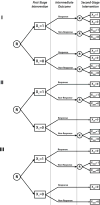Design and Analysis Considerations for Comparing Dynamic Treatment Regimens with Binary Outcomes from Sequential Multiple Assignment Randomized Trials
- PMID: 30555200
- PMCID: PMC6290910
- DOI: 10.1080/02664763.2017.1386773
Design and Analysis Considerations for Comparing Dynamic Treatment Regimens with Binary Outcomes from Sequential Multiple Assignment Randomized Trials
Abstract
In behavioral, educational and medical practice, interventions are often personalized over time using strategies that are based on individual behaviors and characteristics and changes in symptoms, severity, or adherence that are a result of one's treatment. Such strategies that more closely mimic real practice, are known as dynamic treatment regimens (DTRs). A sequential multiple assignment randomized trial (SMART) is a multi-stage trial design that can be used to construct effective DTRs. This article reviews a simple to use 'weighted and replicated' estimation technique for comparing DTRs embedded in a SMART design using logistic regression for a binary, end-of-study outcome variable. Based on a Wald test that compares two embedded DTRs of interest from the 'weighted and replicated' regression model, a sample size calculation is presented with a corresponding user-friendly applet to aid in the process of designing a SMART. The analytic models and sample size calculations are presented for three of the more commonly used two-stage SMART designs. Simulations for the sample size calculation show the empirical power reaches expected levels. A data analysis example with corresponding code is presented in the appendix using data from a SMART developing an effective DTR in autism.
Keywords: Adaptive interventions; Dynamic treatment regimes; Inverse-probability-of-treatment weighting; Sequential multiple assignment randomized trial; sample size.
Conflict of interest statement
Disclosure statement The authors do not have any conflicts of interest to disclose.
Figures


References
-
- Agresti A. Categorical data analysis. John Wiley & Sons; 2013.
-
- Almirall D, DiStefano C, Chang YC, Shire S, Kaiser A, Lu X, Nahum-Shani I, Landa R, Mathy P, Kasari C. Longitudinal effects of adaptive interventions with a speech-generating device in minimally verbal children with asd. Journal of Clinical Child and Adolescent Psychology. 2016;35:1595–1615. - PMC - PubMed
-
- Almirall D, Nahum-Shani I, Sherwood N, Murphy S. Introduction to smart designs for the development of adaptive interventions: with application to weight loss research. Translational Behavioral Medicine. 2014;4:260–274. http://dx.doi.org/10.1007/s13142-014-0265-0 Available at . . - DOI - PMC - PubMed
-
- Auyeung SF, Long Q, Royster EB, Murthy S, McNutt MD, Lawson D, Miller A, Manatunga A, Musselman DL. Sequential multiple-assignment randomized trial design of neurobehavioral treatment for patients with metastatic malignant melanoma undergoing high-dose interferon-alpha therapy. Clinical Trials. 2009;6:480–490. - PMC - PubMed
Grants and funding
LinkOut - more resources
Full Text Sources
Medical
